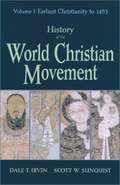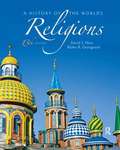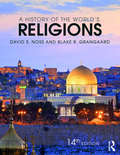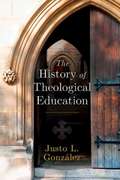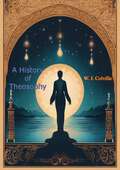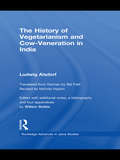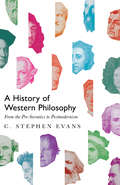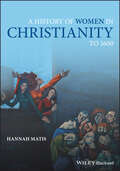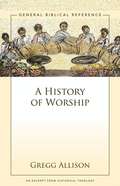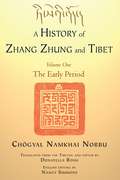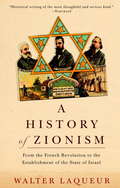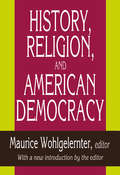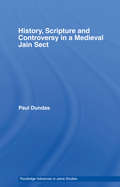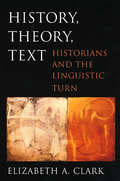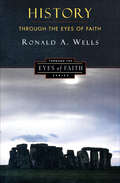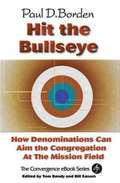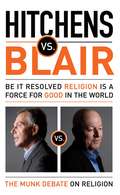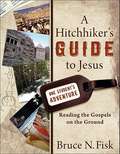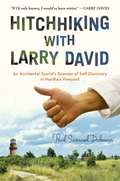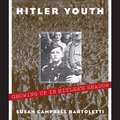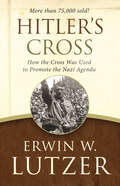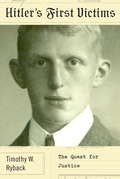- Table View
- List View
History of the World Christian Movement: Earliest Christianity to 1453
by Dale T. Irvin Scott W. SunquistHistory of the World Christian Movement shows that from the beginning Christianity has been a world religion, informed and shaped through the interplay of gospel and culture, church and world.
History of the World in Christian Perspective (4th Edition)
by Jerry CombeeHistory of the World leads students on a journey through time from Creation to the early 21st century. The Christian perspective is the thread that connects the past to the present in this fascinating narrative of world history, teaching students to recognize the hand of God in human events.
A History of the World's Religions
by Blake Grangaard David S. NossA History of the World's Religions bridges the interval between the founding of religions and their present state, and gives students an accurate look at the religions of the world by including descriptive and interpretive details from the original source materials. Refined by over forty years of dialogue and correspondence with religious experts and practitioners around the world, A History of the World's Religions is widely regarded as the hallmark of scholarship, fairness, and accuracy in its field. It is also the most thorough yet manageable history of world religion available in a single volume, treating many subjects largely neglected in other texts.
A History of the World's Religions
by David S. Noss Blake R. GrangaardA History of the World's Religions bridges the interval between the founding of religions and their present state, and gives students an accurate look at the religions of the world by including descriptive and interpretive details from original source materials. Refined by over forty years of dialogue and correspondence with religious experts and practitioners around the world, A History of the World's Religions is widely regarded as the hallmark of scholarship, fairness, and accuracy in its field. It is also the most thorough yet manageable history of world religion available in a single volume. A History of the World’s Religions examines the following topics: Some Primal and Bygone Religions The Religions of South Asia The Religions of East Asia The Religions of the Middle East This fourteenth edition is fully updated throughout with new images and inset text boxes to help guide students and instructors. Complete with figures, timelines and maps, this is an ideal resource for anyone wanting an accessible and comprehensive introduction to the world’s religions.
The History of Theological Education
by Justo L. GonzálezTheological education has always been vital to the Church's life and mission; yet today it is in crisis, lacking focus, direction, but also resources and even students. In the early Church, there is no doubt that to lead worship one had to be able to read and interpret the Bible. In order to lead, it was necessary to know at least something about the history of Israel and the work of God in the Gospels, and interpret that history, making it relevant to daily living. Quickly the Church developed schools for its teachers, whether lay or clergy. A catechetical system was organized through which candidates prepared for baptism were given a basic form of theological education. Hence to be a Christian meant persons knew what and why they believed. But over the years, theological education has come to mean education for clergy and church professionals. It has drifted, seeking new moorings.
A History of Theosophy
by W. J. ColvilleA History of Theosophy by W. J. Colville is a comprehensive account of the development and evolution of theosophical thought and practice. Theosophy is a philosophical and spiritual movement that emerged in the late 19th century, drawing on a range of religious and philosophical traditions from around the world. Colville traces the origins of theosophy back to ancient wisdom traditions, and explores its key figures and ideas, including Helena Blavatsky, Annie Besant, and Krishnamurti. He also examines the impact of theosophy on literature, art, and culture, and its role in shaping modern spirituality. This book provides a detailed and engaging overview of one of the most influential spiritual movements of the modern era.-Print ed.
The History of Vegetarianism and Cow-Veneration in India (Routledge Advances in Jaina Studies)
by Ludwig AlsdorfFor the first time, this influential study by Ludwig Alsdorf is made available to an English speaking audience, translated by Bal Patil. It focuses on two of the most pertinent issues in Indian religion, the history of vegetarianism and cow-veneration, and its historical approach remains relevant to this day. With reference to significant brahminical texts, such as key chapters of the Book of Manu, the book centres on the author’s analysis of the role of Jinism in the history of vegetarianism. The author explores the history of meat-eating in India and its relationship to religious thought and custom, and searches for solutions to the problem of cattle veneration. Besides a comprehensive translation of the original German manuscript "Beiträge zur Geschichte von Vegetarismus und Rinderverehrung in Indien", four important articles directly related to Alsdorf’s work by Kapadia, Heesterman and Schmidt are made available in this new edition. These additional contributions and careful notes by the editor Willem Bollée add a modern perspective to a study that remains a key reference for students and scholars of Religious Studies, Asian Studies and History.
A History of Western Philosophy: From the Pre-Socratics to Postmodernism
by C. Stephen EvansPlato. Aristotle. Augustine. Hume. Kant. Hegel.
A History of Women in Christianity to 1600
by Hannah MatisAn overarching history of women in the Christian Church from antiquity to the Reformation, perfect for advanced undergraduates and seminary students alike A History of Women in Christianity to 1600 presents a continuous narrative account of women’s engagement with the Christian tradition from its origins to the seventeenth century, synthesizing a diverse range of scholarship into a single, easily accessible volume. Locating significant individuals and events within their historical context, this well-balanced textbook offers an assessment of women’s contributions to the development of Christian doctrine while providing insights into how structural and environmental factors have shaped women’s experience of Christianity. Written by a prominent scholar in the field, the book addresses complex discourses concerning women and gender in the Church, including topics often ignored in broad narratives of Christian history. Students will explore the ways women served in liturgical roles within the church, the experience of martyrdom for early Christian women, how the social and political roles of women changed after the fall of Rome, the importance of women in the re-evangelization of Western Europe, and more. Through twelve chapters, organized chronologically, this comprehensive text: Examines conceptions of sex and gender tracing back their roots to the Jewish, Hellenistic, and Roman culture Provides a unique view of key women in the Church in the Middle Ages, including the rise of women’s monasticism and the impact of the Inquisition Compares and contrasts each of the major confessions of the Church during the Reformation Explores lesser-known figures from beyond the Western European traditionA History of Women in Christianity to 1600 is an essential textbook for undergraduate and graduate courses in Christian traditions, historical theology, religious studies, medieval history, Reformation history, and gender history, as well as an invaluable resource for seminary students and scholars in the field.
A History of Worship: A Zondervan Digital Short
by Gregg AllisonDerived from Gregg Allison’s magisterial Historical Theology, this digital resource provides a concise overview of Christian worship as it developed throughout the church’s history. Liturgy, sacraments, the regulative principle, the theology of worship, elements of worship—all of these and more are covered in this concise history. Readers wanting a handy reference resource to the full story of Christian worship from beginning to end will appreciate Allison’s careful and fair-minded overview.
A History of Zhang Zhung and Tibet, Volume One: The Early Period
by Chogyal Namkhai Norbu Nancy Simmons Donatella RossiA History of Zhang Zhung and Tibet, Volume One explores ancient Tibet's Zhang Zhung kingdom and Bon religion that preceded the advent of Buddhism in the seventh century. Countering the long-held idea that Tibet's pre-Buddhist indigenous culture was primitive and undeveloped, this book shares the rich cultural origins of the kingdom of Zhang Zhung--the "cradle of Tibetan culture," which encompassed a vast area of Western and Northern Tibet in an area that includes sacred Mount Kailash. Presenting the meticulous research of internationally known Dzogchen Buddhist teacher and scholar Chogyal Namkhai Norbu, the book investigates the mysteries of Zhang Zhung's Bon religion, a set of shamanistic and animistic beliefs and practices only recently studied by a handful of academic scholars. Offering a critical analysis of a vast array of literary and primary sources, Norbu discusses the role of the Bon traditions within Zhang Zhung's lineages, dynasties, and culture. Examining Zhang Zhung's written language, sacred ornaments, rock carvings, healing practices, music, and magical divination techniques, Norbu contributes to an understanding of the roots of Tibetan Buddhist culture and modern-day Bon religion--a practice followed by an estimated ten percent of Tibetans.Table of Contents:Translator's Foreword; A Technical Note about the Translation; I. The Human Generations of Ancient Zhang Zhung; II. The Bon Lineages of Ancient Zhang Zhung; III. The Royal Lineages of Ancient Zhang Zhung; IV. The Written Language of Ancient Zhang Zhung; V. The Civilization of Ancient Zhang Zhung; Indexes--Tibetan and Zhang Zhung Names and Terms, Textual Sources, Sanskrit Names and Terms, Chinese Names and Terms
A History of Zionism: From the French Revolution to the Establishment of the State of Israel
by Walter LaqueurThe original 1972 edition is cited in In his new preface, Laqueur, a Washington, DC-based historian, addresses challenges to the movement since he first traced the history of Zionism from the French Revolution to the 1948 founding of the state of Israel. This reissue includes maps, photos, and a glossary. Annotation ©2004 Book News, Inc. , Portland, OR (booknews. com)
History of Zoroastrianism
by Maneckji Nusservanji DhallaThis book is the revised and much enlarged edition of my Zoroastrian Theology,which has been out of print for the past fifteen years. The publication of my Zoroastrian Civilization, and Our Perfecting World, Zarathushtra's Way of Life, and professional duties have delayed the completion of the work. New material in several chapters have been inserted and nineteen new chapters are added to the book. The book is given a concise account of the religious beliefs and practices prevalent among the Zoroastrians and their early Iranian ancestors from the pre-Gathic times to the present day and named the book History of Zoroastrianism.
History, Religion, and American Democracy
by Maurice WohlgelernterHistory, Religion, and American Democracy provides a fundamental review of four major themes: naturalism and supernaturalism in an American context; issues in the history of Judaism; American social philosophy; and the teaching and learning of democratic ideals in a pluralistic postmodern environment. This book provides a naturalistic context for the deep analysis of religious, theological, as well as social and political themes.
History, Scripture and Controversy in a Medieval Jain Sect (Routledge Advances in Jaina Studies)
by Paul DundasExamining the history and intellectual activity of the medieval Svetambara Jain renunciant order, the Tapa Gaccha, this book focuses on the consolidation by the Tapa Gaccha from the thirteenth century of its identity as the leading Svetambara order. The author argues that this was variously effected by negotiating the primacy of lineage, the posthumous divinity of one of its leaders, the validity of styles of scriptural exegesis and customary practice and the status of non-Jains through the medium of chronicles and poetry and polemical engagement with other Jain orders and dissident elements within its own ranks. Drawing on largely unstudied primary sources, the author demonstrates how Tapa Gaccha writers created a sophisticated intellectual culture which was a vehicle for the maintenance of sectarian identity in the early modern period. The book explores issues which have been central to our understanding of many of the questions currently being asked about the development not just of Jainism but of South Asian religions in general, such as the manner in which authority is established in relation to texts, the relationship between scripture, commentary and tradition and tensions both between and within sects.
History, Theory, Text: Historians and the Linguistic Turn
by Elizabeth A. ClarkIn this work of sweeping erudition, one of our foremost historians of early Christianity considers a variety of theoretical critiques to examine the problems and opportunities posed by the ways in which history is written. Elizabeth Clark argues forcefully for a renewal of the study of premodern Western history through engagement with the kinds of critical methods that have transformed other humanities disciplines in recent decades. History, Theory, Text provides a user-friendly survey of crucial developments in nineteenth- and twentieth-century debates surrounding history, philosophy, and critical theory. Beginning with the "noble dream" of "history as it really was" in the works of Leopold von Ranke, Clark goes on to review Anglo-American philosophies of history, schools of twentieth-century historiography, structuralism, the debate over narrative history, the changing fate of the history of ideas, and the impact of interpretive anthropology and literary theory on current historical scholarship. In a concluding chapter she offers some practical case studies to illustrate how attending to theoretical considerations can illuminate the study of premodernity. Written with energy and clarity, History, Theory, Text is a clarion call to historians for richer and more imaginative use of contemporary theory.
History Through the Eyes of Faith: Christian College Coalition Series
by Ronald A. WellsIntegrating faith with introductory Western history, this text provides a Christian perspective on the major epochs, issues, and events of Western Civilization. It details the role of the Greeks and Hebrews, Jesus in history, the Renaissance, and more.
Hit the Bullseye: How Denominations Can Aim the Congregation at the Mission Field (The Convergence eBook Series)
by Paul D. BordenThis book is not an attempt to offer hope, help, or even advice on what denominations need to do. However, it is a book about a significant turn-around of a middle-level administration of justice in one Protestant denomination and it does offer hope that other like administrations might be able to experience a better and more effective existence. Everyone's experience is unique and therefore cannot be replicated. However, the implementation of foundational all-encompassing principles, the development of new strategies, and the performance of specific tactics that are successful in one situation does offer hope to others that their modeling of the principles, adapting the strategies, and creating specific tactics to fit their context can bring change. "This book is a gutsy look at denominational life, leadership and vision, and offers new paradigms for the local church, middle judicatories and national denominational life. A must-read for anyone interested in bringing renewal to the local church and our denomination. Clearly, Borden has hit the bull's-eye with regard not only to our denomination's needs but also how renewal begins in the local church." - ABE News Foreword to Hit the Bullseye <span style="mso-spacerun: yes"> by Leith Anderson July 2003 "Some look at things that are, and ask why. I dream of things that never were and ask why not?" <p class="MsoNormal" align="center" style="text-align:center;mso-layout-grid-align: none;text-autospace:none">-- George Bernard Shaw There are approximately 400,000 churches in the United States and the vast majority of them belong to denominations. Some are healthy, vibrant, and growing. Most are tired, struggling, not growing, and don't know what to do. Plenty of critics and cynics take surveys, analyze data, and write books about what is wrong with the churches of America. As if following the theology of Chicken Little they are convinced that the sky is falling and there is little we can do except seek cover. Proposals for renewal often are offered by theorists who tell practitioners what to do but have never actually done it themselves. What if? What if there was a way to help declining churches to grow? What if we could teach pastors how to lead their congregations to spiritual renewal?<span style="mso-spacerun: yes"> What if thousands of churches changed from maintenance to mission? What if a movement began with 200 churches that grew to 200,000 churches? What if millions of unchurched people came into lasting relationships with Jesus Christ and the church? What if the denominations of America with all of their people, property, and potential became the epicenter of this spiritual earthquake that became known as the Great Awakening of the 21st Century? Maybe all this sounds too good to be true. Well, it has already begun. Centered in the earthquake zone of northern California, the American Baptist Churches of the West have demonstrated that a plateaued and declining region of mainline congregations can become a model of healthy and growing congregations. They have overcome the usual excuses that "our churches are too small," "we have too many older people and congregations," and "property here is too expensive." They followed a powerful formula of biblical strategies, courageous leadership, and much hard work. What is most amazing is that the turnaround took less than five years. Why not? Here is the dream. Denominational leaders, executive ministers, bishops, district superintendents, regional directors, seminary teachers, pastors, and lay leaders will discover what God has done in northern California and say, "Why not here?" "With a few creative adaptations we can do the same thing in our denomination and in our churches." They will start small and multiply. They will risk their traditions, finances, staff, and jobs. They will respond to misunderstanding with teaching and take criticism with grace. Then there will be one successful church transformation--new vision, new faith, new ...
Hitchens vs. Blair: Be It Resolved Religion Is a Force for Good in the World (The Munk Debates)
by Tony Blair Christopher HitchensIntellectual juggernaut and staunch atheist Christopher Hitchens goes head-to-head with former British Prime Minister Tony Blair, one of the Western world’s most openly devout political leaders, on the highly charged topic of religion. Few world leaders have had a greater hand in shaping current events than Blair; few writers have been more outspoken and polarizing than Hitchens. In this edition of The Munk Debates -- Canada’s premier international debate series -- Hitchens and Blair square off on the contentious questions that continue to dog the topic of religion in our globalized world: How does faith influence our actions? What is the role of people of faith in the public sphere? Is religious doctrine rigid, or should we allow for flexibility in our interpretations? This exclusive debate, which played out to a sold-out audience, is now available in print form, along with candid interviews with Hitchens and Blair. Sharp, provocative, and thoroughly engrossing, Hitchens vs. Blair is a rigorous and electrifying intellectual sparring match on the oldest question: Is religion a force for good in the world?
A Hitchhiker's Guide To Jesus: Reading The Gospels On The Ground
by Bruce FiskThis imaginative approach to Jesus studies chronicles the journey of Norm, a fictional college graduate who travels to the Middle East to see if he can study Jesus and follow him at the same time, and if curiosity will make him a better disciple or no disciple at all. <P><P> Norm sets out on an adventure to investigate the New Testament and the life of Jesus for himself, hitchhiking simultaneously across the Gospels and the land. His travels offer students and lay readers a creative and engaging way to explore many of the major questions in Jesus studies today. Will Norm be able to reconcile his Christian faith with critical scholarship? <P><P>As readers follow his faith journey, they learn the importance of asking probing questions. The book's lavish, journal-style interior design--featuring maps, photos, doodles, sketches, and email exchanges between Norm and his professor--makes it fun to read.
Hitchhiking with Larry David
by Paul Samuel DolmanA memoir about a broken-hearted, middle-aged man who stumbles upon solace, meaning, and Larry David while hitchhiking his way around Martha's Vineyard One summer day on Martha's Vineyard Paul Samuel Dolman was hitchhiking, and none other than Larry David pulled over and asked, "You're not a serial killer or something, are you?" The comedic writer and actor from Seinfeld and Curb Your Enthusiasm not only gave Dolman a ride, but helped him find his way during his summer of soul-searching and hitchhiking. Dolman found himself on Martha's Vineyard that summer having made the catastrophic mistake of visiting "The Parental Asylum" in the wake of a painful breakup. His mother is welcoming, albeit senile and neurotically rigid. But his dad "only has the social energy to be nice to humans for about 10 minutes a day." Desperately seeking companionship, Dolman begins hitchhiking around the island and meets a wide array of characters: the super-rich and the homeless, movie stars and common folk, and, of course, Mr. David. Astonishingly, it is Dolman's growing friendship with the famous comedian that becomes the lodestar of his spiritual quest. (Yes, Larry David gets deep!) Written with disarming honest humor and perfectly capturing Larry David's unique comic genius, Hitchhiking with Larry David will leave readers simultaneously laughing and crying as they ponder the mystery and spirituality of life.
Hitler Youth: Growing Up in Hitler's Shadow
by Susan Campbell BartolettiIn her first full-length nonfiction title since winning the Robert F. Sibert Award, Susan Campbell Bartoletti explores the riveting and often chilling story of Germany's powerful Hitler Youth groups.<P><P> "I begin with the young. We older ones are used up... But my magnificent youngsters! Look at these men and boys! What material! With them, I can create a new world." --Adolf Hitler, Nuremberg 1933<P> By the time Hitler became Chancellor of Germany in 1933, 3.5 million children belonged to the Hitler Youth. It would become the largest youth group in history. Susan Campbell Bartoletti explores how Hitler gained the loyalty, trust, and passion of so many of Germany's young people. Her research includes telling interviews with surviving Hitler Youth members.<P> Newbery Medal Honor book and Sibert Honor book
Hitler's Cross: How the Cross Was Used to Promote the Nazi Agenda
by Erwin W. LutzerThe story of Nazi Germany is one of conflict between two saviors and two crosses. &“Deine Reich komme,&” Hitler prayed publicly—&“Thy Kingdom come.&” But to whose kingdom was he referring?When Germany truly needed a savior, Adolf Hitler falsely assumed the role. He directed his countrymen to a cross, but he bent and hammered the true cross into a horrific substitute: a swastika.Where was the church through all of this? With a few exceptions, the German church looked away while Hitler inflicted his &“Final Solution&” upon the Jews. Hitler&’s Cross is a chilling historical account of what happens when evil meets a silent, shrinking church, and an intriguing and convicting exposé of modern America&’s own hidden crosses.Erwin W. Lutzer extracts a number of lessons from this dark chapter in world history, such as:The dangers of confusing church and stateThe role of God in human tragedyThe parameters of Satan's freedomHitler's Cross is the story of a nation whose church forgot its call and discovered its failure way too late. It is a cautionary tale for every church and Christian to remember who the true King is.
Hitler's Cross: How the Cross Was Used to Promote the Nazi Agenda
by Erwin W. LutzerThe story of Nazi Germany is one of conflict between two saviors and two crosses. &“Deine Reich komme,&” Hitler prayed publicly—&“Thy Kingdom come.&” But to whose kingdom was he referring?When Germany truly needed a savior, Adolf Hitler falsely assumed the role. He directed his countrymen to a cross, but he bent and hammered the true cross into a horrific substitute: a swastika.Where was the church through all of this? With a few exceptions, the German church looked away while Hitler inflicted his &“Final Solution&” upon the Jews. Hitler&’s Cross is a chilling historical account of what happens when evil meets a silent, shrinking church, and an intriguing and convicting exposé of modern America&’s own hidden crosses.Erwin W. Lutzer extracts a number of lessons from this dark chapter in world history, such as:The dangers of confusing church and stateThe role of God in human tragedyThe parameters of Satan's freedomHitler's Cross is the story of a nation whose church forgot its call and discovered its failure way too late. It is a cautionary tale for every church and Christian to remember who the true King is.
Hitler's First Victims
by Timothy W. RybackThe remarkable story of Josef Hartinger, the German prosecutor who risked everything to bring to justice the first killers of the Holocaust and whose efforts would play a key role in the Nuremberg tribunal. Before Germany was engulfed by Nazi dictatorship, it was a constitutional republic. And just before Dachau Concentration Camp became a site of Nazi genocide, it was a state detention center for political prisoners, subject to police authority and due process. The camp began its irrevocable transformation from one to the other following the execution of four Jewish detainees in the spring of 1933. Timothy W. Ryback's gripping and poignant historical narrative focuses on those first victims of the Holocaust and the investigation that followed, as Hartinger sought to expose these earliest cases of state-condoned atrocity. In documenting the circumstances surrounding these first murders and Hartinger's unrelenting pursuit of the SS perpetrators, Ryback indelibly evokes a society on the brink--one in which civil liberties are sacrificed to national security, in which citizens increasingly turn a blind eye to injustice, in which the bedrock of judicial accountability chillingly dissolves into the martial caprice of the Third Reich. We see Hartinger, holding on to his unassailable sense of justice, doggedly resisting the rising dominance of Nazism. His efforts were only a temporary roadblock to the Nazis, but Ryback makes clear that Hartinger struck a lasting blow for justice. The forensic evidence and testimony gathered by Hartinger provided crucial evidence in the postwar trials. Hitler's First Victims exposes the chaos and fragility of the Nazis' early grip on power and dramatically suggests how different history could have been had other Germans followed Hartinger's example of personal courage in that time of collective human failure.From the Hardcover edition.
